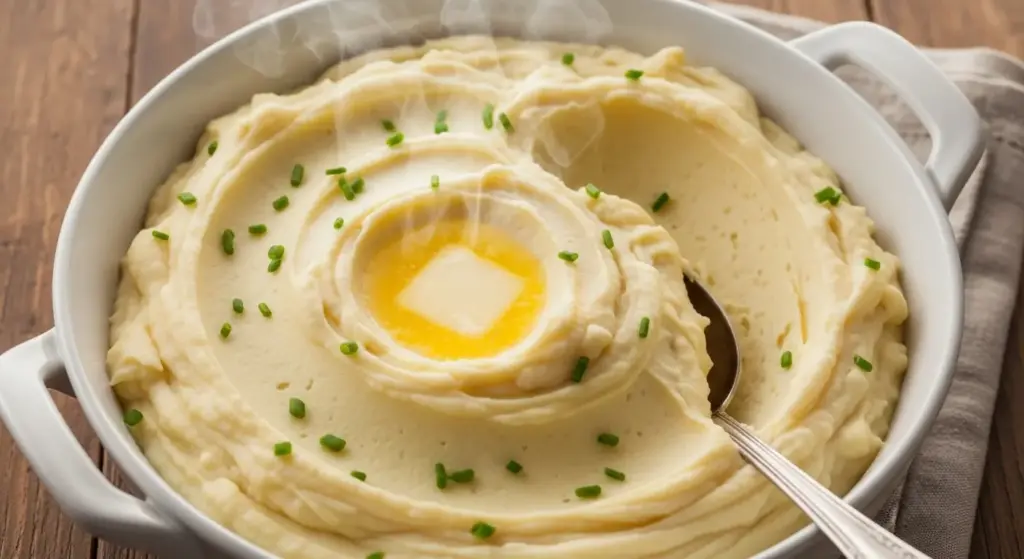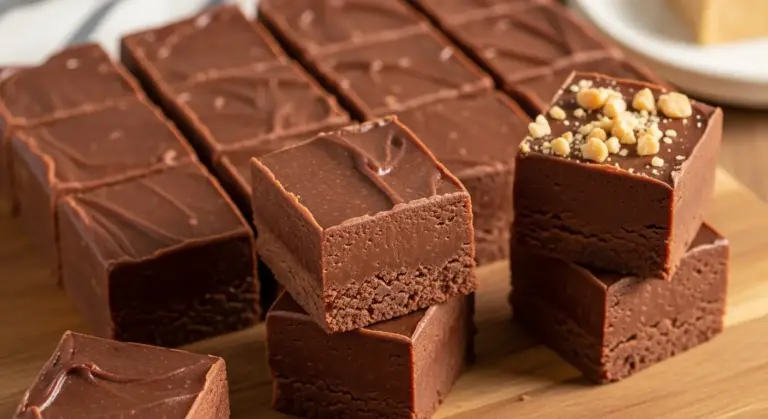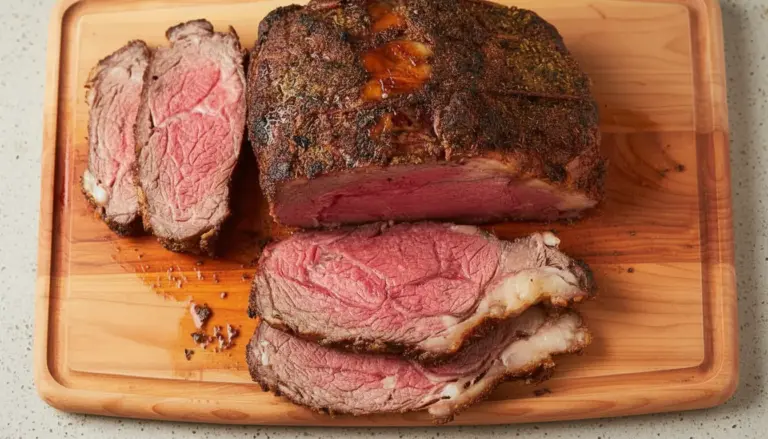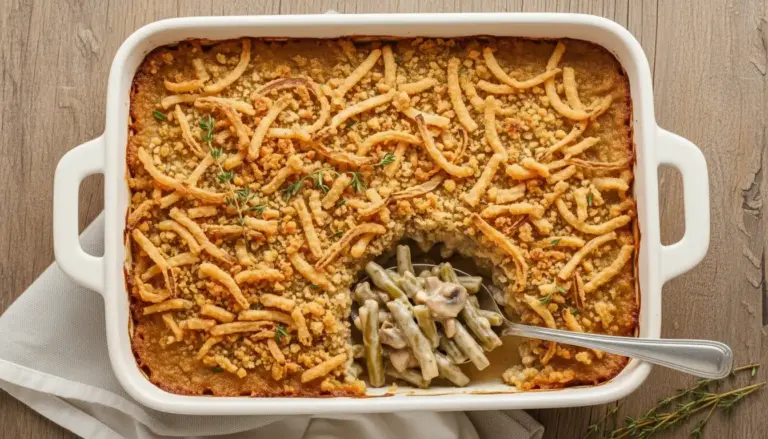I’ve been making mashed potatoes for over a decade now, and I can’t tell you how many times I’ve messed them up before getting it just right.
My first attempt was a disaster. I thought I could just boil potatoes and mash them with a fork, and what I ended up with was a lumpy, gluey mess that nobody wanted to touch. My family still jokes about those “cement potatoes” to this day.
But after years of trial and error, I finally cracked the code to making the creamiest, fluffiest mashed potatoes that have everyone asking for seconds. The trick isn’t just about the potatoes you use (though that matters too), it’s about timing, temperature, and technique.
| Quick Recipe Summary | |
|---|---|
| Prep Time | 15 minutes |
| Cook Time | 20 minutes |
| Total Time | 35 minutes |
| Servings | 6 servings |
| Difficulty Level | Easy |
Why You’ll Love This Mashed Potatoes Recipe
This isn’t your average side dish recipe. These mashed potatoes are rich, velvety, and have just the right amount of buttery goodness that makes them irresistible.
They’re incredibly versatile too. You can dress them up for a fancy dinner party or keep them simple for a Tuesday night meal with the family.
The texture is what really sets this recipe apart. No gluey, paste-like consistency here.
Using the right type of potato and not over-mixing is crucial, and I’ll walk you through exactly how to avoid those common mistakes. Plus, this recipe comes together in under 40 minutes, making it perfect for busy weeknights or last-minute holiday gatherings.
I’ve also discovered that this dinner rolls recipe is the perfect accompaniment to these mashed potatoes.
- Incredibly creamy texture: No lumps, no gluey mess, just smooth and fluffy perfection
- Restaurant-quality results: These taste like something you’d order at an upscale steakhouse
- Simple ingredients: You probably already have everything you need in your kitchen
- Make-ahead friendly: You can prep these a few hours in advance and reheat them
- Crowd-pleaser: I’ve never met anyone who doesn’t love a good bowl of mashed potatoes
- Customizable: Easy to adapt with different herbs, cheeses, or flavor variations
Ingredients
The ingredient list is refreshingly simple, but quality matters here. I learned this the hard way when I tried to cut corners with margarine instead of real butter.
Here’s what you’ll need for the creamiest mashed potatoes you’ve ever made:
- 3 pounds (1.4 kg) Yukon Gold potatoes, peeled and cut into 2-inch chunks
- 1 cup (240 ml) heavy cream, warmed
- ½ cup (115 g) unsalted butter, cut into pieces and at room temperature
- 1 teaspoon (6 g) salt, plus more to taste
- ½ teaspoon (1 g) black pepper, freshly ground
- ¼ cup (60 ml) sour cream (optional, for extra tanginess)
- 2 cloves garlic, minced (optional)
- 2 tablespoons (8 g) fresh chives, chopped (for garnish)
Kitchen Equipment Needed
Having the right tools makes this recipe so much easier. I used to struggle with a regular hand masher until I invested in a proper potato ricer, and it changed everything.
Here’s what you’ll need:
- Large pot (at least 6-quart capacity) for boiling potatoes
- Colander for draining
- Potato ricer or masher (ricer gives the smoothest texture)
- Mixing bowl (if using a ricer)
- Wooden spoon for stirring
- Small saucepan for warming cream
- Sharp knife and cutting board
- Measuring cups and spoons
- Serving bowl
Recommended Products for This Recipe
I’ve tested countless tools and ingredients over the years, and these are the products that consistently give me the best results. These aren’t just random recommendations; they’re items I actually use in my own kitchen.
1. OXO Good Grips Potato Ricer
This tool was an absolute revelation for me. I struggled for years with lumpy mashed potatoes until I finally invested in a quality ricer, and now I can’t imagine making them any other way. The ricer creates the fluffiest, most restaurant-quality texture by pushing the potatoes through tiny holes, and it’s so much easier on your arms than a traditional masher.
2. Kerrygold Pure Irish Butter
I always keep a few blocks of this in my fridge because the rich, creamy flavor is unmatched. Regular butter works fine, but Kerrygold takes these mashed potatoes from good to absolutely incredible. The grass-fed difference is noticeable, and it melts beautifully into the potatoes without any greasiness.
3. All-Clad Stainless Steel Pot
This pot heats evenly and is large enough to boil potatoes without crowding them, which helps them cook more uniformly. I’ve had mine for over eight years, and it still looks brand new. The heavy bottom prevents hot spots that can cause some pieces to overcook while others remain underdone.
4. Organic Valley Heavy Whipping Cream
The quality of your cream directly impacts the final texture and flavor. This organic cream is incredibly rich and adds a luxurious silkiness to the potatoes. I’ve compared it side-by-side with regular cream, and the difference is noticeable in both taste and mouthfeel.
Another favorite: creamed spinach
Step-by-Step Instructions: How to Make Mashed Potatoes
Follow these detailed steps for perfect results every single time. I’m walking you through exactly what I do in my kitchen, including the little tricks that make a big difference.
1. Prepare the Potatoes
Getting the potatoes ready properly is the foundation of great mashed potatoes. This step sets you up for success.
- Peel all 3 pounds of potatoes using a vegetable peeler, making sure to remove any eyes or dark spots
- Cut the peeled potatoes into evenly-sized chunks, about 2 inches (5 cm) each, so they cook at the same rate
- Place the cut potatoes in a large bowl of cold water as you work to prevent them from oxidizing and turning brown
- Rinse the potatoes under cold water once all are cut to remove excess starch, which can make them gluey
2. Boil the Potatoes
The boiling technique is critical. Starting with cold water helps the potatoes cook evenly from the outside in.
- Drain the potatoes from the soaking water and place them in your large pot
- Cover the potatoes completely with cold water, adding about 2 inches of water above the potato level
- Add 1 tablespoon of salt to the water (this seasons the potatoes from the inside out)
- Place the pot over high heat and bring to a boil, which should take about 8-10 minutes
- Once boiling, reduce the heat to medium and maintain a gentle simmer
- Cook for 15-20 minutes, or until a fork easily pierces through the largest potato chunk with no resistance
- Test multiple pieces to ensure even cooking throughout the batch
3. Warm the Cream and Butter
While the potatoes are cooking, prepare your dairy ingredients. Cold cream and butter will cool down your potatoes and affect the texture.
- Pour 1 cup of heavy cream into a small saucepan
- If using garlic, add the minced cloves to the cream now
- Heat the cream over low heat until it’s just warm (not boiling), about 3-4 minutes
- Remove from heat and add the butter pieces to the warm cream, allowing them to melt together
- Stir occasionally to help the butter incorporate smoothly
- Keep the mixture warm but not hot while you finish the potatoes
4. Drain and Dry the Potatoes
This is a step many people skip, but it makes a huge difference in preventing watery mashed potatoes.
- Once the potatoes are fork-tender, drain them immediately in a colander
- Return the drained potatoes to the same pot (now empty)
- Place the pot back on the burner over low heat for 1-2 minutes, shaking the pot occasionally
- This evaporates any excess moisture clinging to the potatoes, which would otherwise dilute your mashed potatoes
- Watch carefully to ensure the potatoes don’t stick or burn on the bottom
You might also enjoy: sweet potato casserole
5. Rice or Mash the Potatoes
This is where the magic happens. The method you use here determines the final texture.
- If using a potato ricer, set up your mixing bowl and rice the hot potatoes directly into it, working in batches
- Press down firmly on the ricer handle to push all the potato through the holes
- If using a masher, mash the potatoes directly in the pot using a up-and-down motion (never stir in circles)
- Continue mashing until there are no visible lumps, but don’t over-work them
- The potatoes should look light and fluffy at this stage
6. Add the Cream Mixture
Adding the warm dairy gradually ensures even distribution and prevents the potatoes from becoming soupy.
- Pour about half of the warm cream and butter mixture over the mashed potatoes
- Using a wooden spoon, gently fold the mixture into the potatoes with broad strokes
- Add the remaining cream mixture gradually, checking the consistency as you go
- If adding sour cream, fold it in at this point for a subtle tang
- Gently mix until everything is just combined and the potatoes are creamy
7. Season and Serve
The final seasoning is crucial. Potatoes need more salt than you might think.
- Taste the mashed potatoes and add salt gradually, starting with ½ teaspoon and adjusting to your preference
- Add the black pepper and stir gently to distribute
- Transfer the mashed potatoes to a warmed serving bowl
- Create a small well in the center and add an extra pat of butter if desired
- Garnish with freshly chopped chives
- Serve immediately while hot and at their fluffiest
Tips for The Best Mashed Potatoes
These are the tricks I wish someone had told me when I first started making mashed potatoes. They’re the difference between good and absolutely incredible.
Here are my most valuable tips:
- Choose the right potato variety: Yukon Golds are my favorite because they’re naturally creamy and buttery, but russets work well too for a fluffier texture. Avoid red potatoes or waxy varieties as they can become gluey.
- Cut potatoes uniformly: When your chunks are all the same size, they cook evenly, preventing some pieces from being mushy while others are undercooked.
- Don’t overcook: Overcooked potatoes absorb too much water and become waterlogged. Test them frequently after 15 minutes of simmering.
- Always warm your dairy: Cold cream and butter will cool down your potatoes and make them difficult to mix smoothly. I keep my cream mixture on low heat until I’m ready to use it.
- Use a ricer if possible: I resisted buying one for years, but a potato ricer creates the smoothest texture without overworking the potatoes.
- Never use a food processor or blender: These tools will activate too much starch and turn your potatoes into wallpaper paste. Trust me, I learned this the hard way.
- Work quickly once potatoes are drained: Hot potatoes absorb butter and cream better than lukewarm ones.
- Don’t overmix: Once you add the cream and butter, fold gently just until combined. Overworking develops gluten from the potato starch.
- Season generously: Potatoes are bland on their own and need plenty of salt to bring out their natural flavor. Always taste and adjust.
- Serve immediately: Mashed potatoes are best right after making them, when they’re hot and fluffy. They lose that perfect texture as they sit.
Serving Suggestions

These mashed potatoes are incredibly versatile and pair beautifully with so many different main dishes. I love how they soak up gravies and sauces.
They’re the perfect comfort food side that works for both casual weeknight dinners and special occasions. Here’s what I love serving them with:
- Classic roast chicken or turkey for holiday meals
- Meatloaf with rich brown gravy
- Pan-seared steak or filet mignon for an elegant dinner
- Slow cooker pot roast with all those delicious pan juices
- Braised short ribs with red wine sauce
- Thanksgiving turkey with cranberry sauce and all the fixings
- Swedish meatballs with cream sauce
- Simple grilled pork chops for a quick weeknight meal
- Sausage balls as part of a comfort food spread
For a lighter option, try: grilled vegetable skewers
Variations of Mashed Potatoes
One of the best things about this base recipe is how easily you can customize it. I’m always experimenting with different flavors depending on what I’m serving.
Try these delicious variations:
- Garlic mashed potatoes: Add 4-6 cloves of roasted garlic to the cream mixture before adding to potatoes. Roasting the garlic mellows its flavor and makes it sweet and buttery.
- Loaded mashed potatoes: Fold in ½ cup of shredded cheddar cheese, ¼ cup of crispy bacon bits, and 2 tablespoons of chopped green onions after mashing.
- Herb-infused: Stir in 2 tablespoons of fresh herbs like rosemary, thyme, or parsley. I especially love this version with roasted chicken.
- Horseradish mashed potatoes: Add 2-3 tablespoons of prepared horseradish for a spicy kick that pairs perfectly with prime rib or beef tenderloin.
- Parmesan and black pepper: Mix in ½ cup of freshly grated Parmesan cheese and an extra teaspoon of coarsely ground black pepper for an Italian twist.
- Sour cream and chive: Increase the sour cream to ½ cup and add ¼ cup of fresh chives for a tangy, fresh flavor.
- Cream cheese mashed potatoes: Add 4 ounces of softened cream cheese along with the butter for an extra creamy, tangy variation.
- Brown butter: Brown your butter in a skillet until it’s nutty and golden before adding it to the potatoes for a sophisticated, caramelized flavor.
- Truffle mashed potatoes: Add 1-2 teaspoons of truffle oil and top with shaved truffle for an luxurious upgrade.
Read Also: Hashbrown Casserole
Storage and Reheating
I always make extra because mashed potatoes are one of those things that taste even better as leftovers. Plus, knowing how to store and reheat them properly means you can prep ahead for busy weeks.
Here’s how to keep them fresh:
- Refrigerator storage: Transfer cooled mashed potatoes to an airtight container and refrigerate for up to 4 days. Press plastic wrap directly onto the surface before sealing to prevent a skin from forming.
- Freezer storage: Place completely cooled mashed potatoes in freezer-safe containers or bags, removing as much air as possible. Freeze for up to 2 months. The texture may be slightly different after freezing, so I recommend adding a bit of extra cream when reheating.
- Reheating on the stovetop: Place mashed potatoes in a pot over low heat, adding 2-3 tablespoons of milk or cream. Stir frequently until heated through, about 5-7 minutes.
- Reheating in the microwave: Transfer to a microwave-safe bowl, add a splash of milk or cream, and cover with a damp paper towel. Heat in 1-minute intervals, stirring between each, until hot throughout.
- Reheating in the oven: Spread mashed potatoes in a buttered baking dish, dot with butter, cover with foil, and bake at 350°F (175°C) for 20-25 minutes until warmed through.
- Reviving dried-out leftovers: If your refrigerated mashed potatoes have dried out, simply add more warm cream or milk and butter while reheating, stirring gently to reincorporate.
- Make-ahead tip: You can make these mashed potatoes up to 2 hours ahead. Keep them warm in a slow cooker set on low, adding a bit of extra cream if needed to maintain the consistency.
Nutritional Facts
This nutritional information is for one serving (based on 6 servings total), and I’m using the recipe as written with all optional ingredients.
- Calories: 385
- Total Fat: 24g
- Saturated Fat: 15g
- Cholesterol: 75mg
- Sodium: 425mg
- Total Carbohydrates: 38g
- Dietary Fiber: 3g
- Sugars: 2g
- Protein: 5g
- Vitamin C: 30% of Daily Value
- Potassium: 18% of Daily Value
- Calcium: 6% of Daily Value
- Iron: 8% of Daily Value
Health Benefits of Key Ingredients
While mashed potatoes are definitely a comfort food, they’re not without nutritional value. I was pleasantly surprised to learn about the benefits of the ingredients I’ve been using all along.
Here’s what makes this dish better than you might think:
- Potatoes: Despite their reputation, potatoes are actually quite nutritious. They’re an excellent source of vitamin C, which supports your immune system, and vitamin B6, which helps with brain development and function. One medium potato provides about 30% of your daily vitamin C needs. They’re also high in potassium, containing even more than a banana, which helps regulate blood pressure and supports heart health. The resistant starch in potatoes can also benefit gut health.
- Butter: While high in saturated fat, butter provides fat-soluble vitamins A, D, E, and K. Vitamin A is crucial for eye health and immune function. Butter from grass-fed cows (like the Kerrygold I recommend) contains higher levels of omega-3 fatty acids and conjugated linoleic acid (CLA), which has been studied for its potential anti-inflammatory properties.
- Heavy cream: Rich in calcium for bone health and vitamin A for vision and immune support. The fat in cream helps your body absorb fat-soluble vitamins from other foods you’re eating. It also provides a feeling of satiety, which can help prevent overeating.
- Garlic (if using): Contains allicin, a compound with potent medicinal properties. Garlic has been shown to boost immune function, reduce blood pressure, and may even help prevent certain types of cancer. It’s also rich in antioxidants that protect against cell damage and aging.
- Sour cream (if using): Provides probiotics that support digestive health and calcium for strong bones. The beneficial bacteria in cultured sour cream can help maintain a healthy gut microbiome.
FAQs About Mashed Potatoes
These are the questions I get asked most often when I share this recipe with friends and family. I’ve answered them based on my own experience and what has worked best in my kitchen.
1. Why are my mashed potatoes gummy or gluey?
This happens when potatoes are overworked. When you overmix, you break down the potato cells and release too much starch, which creates a gluey texture. It can also happen if you use a food processor or blender, which activates too much starch too quickly. The solution is to use a ricer or masher and fold gently, stopping as soon as the ingredients are just combined.
2. Can I make mashed potatoes ahead of time?
Absolutely! I do this all the time for holiday meals. Make them as directed, then transfer to a slow cooker set on low or warm. Add an extra ¼ cup of warm cream to keep them loose, and stir occasionally. They’ll stay perfect for up to 2 hours this way. For longer storage, refrigerate them and reheat using one of the methods I described in the storage section.
Read Also: Green Bean Casserole
3. What’s the best type of potato for mashed potatoes?
Yukon Gold potatoes are my top choice because they have a naturally buttery flavor and creamy texture. They strike the perfect balance between starchy and waxy. Russet potatoes work well too if you prefer a fluffier, lighter texture. I avoid red potatoes or fingerlings because they’re too waxy and can become gluey when mashed.
4. How do I fix lumpy mashed potatoes?
If you catch lumps early, you can press the potatoes through a fine-mesh strainer or potato ricer. If they’ve already been mixed with cream and butter, you’re somewhat limited. Your best bet is to use a potato masher to gently work out the larger lumps, but be careful not to overmix. The key is preventing lumps in the first place by making sure potatoes are fully cooked and using a ricer from the start.
5. Why do my mashed potatoes turn out watery?
Watery mashed potatoes usually result from potatoes that weren’t dried properly after draining. Always return the drained potatoes to the hot pot for a minute or two to evaporate excess moisture. Another cause is adding too much liquid too quickly. Add your cream mixture gradually and stop when you reach your desired consistency. You can always add more, but you can’t take it away.
Final Thoughts
Making perfect mashed potatoes has become second nature to me now, but I remember how intimidating it felt when I first started cooking. The beauty of this recipe is that once you nail the basic technique, you’ll never need another one.
I make these mashed potatoes at least twice a month, and they never get old. They’re comforting, satisfying, and remind me of all the family dinners and holidays I’ve shared over the years.
Give this recipe a try and I promise you’ll be amazed at how something so simple can be so incredibly delicious. Drop a comment below and let me know how yours turned out, and don’t forget to share this recipe with someone who needs a good side dish in their life!
Recommended:
- Roasted Brussels Sprouts with Bacon
- Maple Glazed Carrots
- Honey Butter
- Coleslaw
- Cranberry Sauce
- Thanksgiving Stuffing
- Homemade Biscuit
- Baked Oatmeal
- Cheese Ball
- Mississippi Pot Roast




